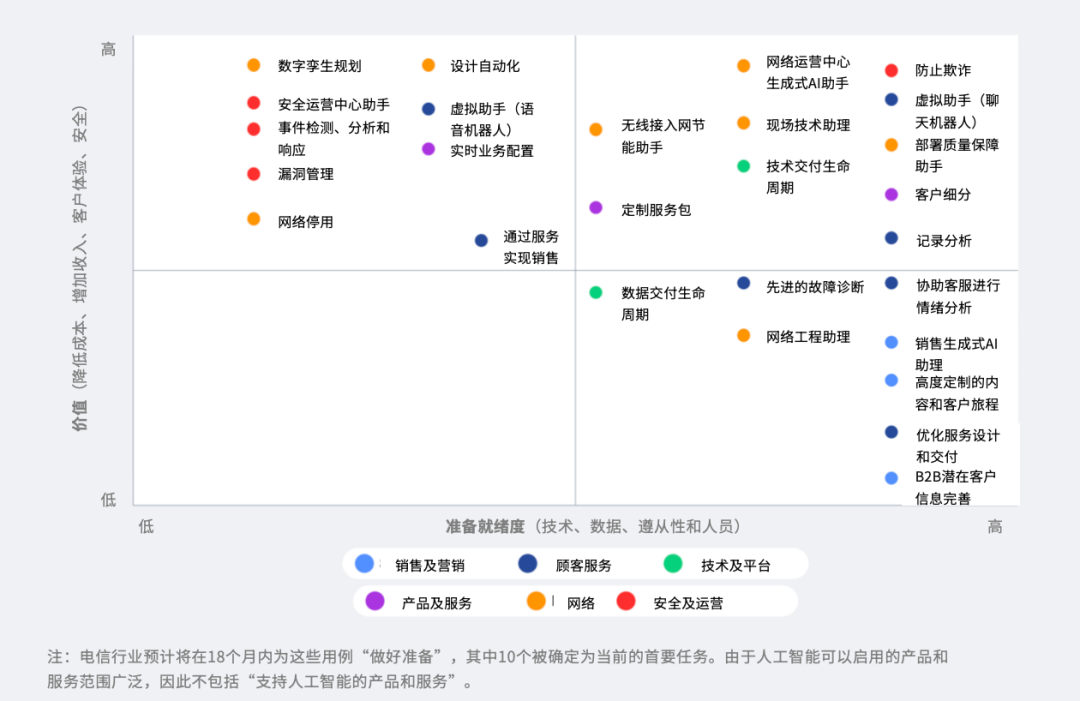

Telecom companies must leverage generative AI to stay competitive.
Image source:Unsplash/Diana den Held
Francesco Venturini
Accenture Senior Managing Director
Global Head of the Communications and Media Industry
Bart Valkhof
Head of the Information and Communications Technology Industry at the World Economic Forum
While telecom companies have long since started leveraging artificial intelligence, harnessing generative AI has become the key to addressing today’s challenges.
Artificial intelligence can help reduce costs through automation, drive business growth with hyper-personalized marketing, and enhance customer satisfaction via AI-powered chatbots and service assistants.
To stay competitive, telecom companies must transform into "Techcos"—highly automated, AI-driven enterprises that deliver services far beyond traditional connectivity.
First, some great news: As a technology-native industry, the telecommunications sector is naturally adept at integrating new technologies into its operations. With over a decade of experience deploying AI, machine learning and predictive AI have already become integral parts of their processes—found in nearly every corner of the industry.
From this perspective, the telecommunications industry is well-positioned to fully leverage the advantages offered by generative AI. Recent research also supports this view, revealing that the telecom sector leads in spending on generative AI compared to most other industries—and its employees generally hold overwhelmingly positive attitudes toward the technology.
But here's the question: Whether or not telecom companies can seize the AI opportunity will determine their survival and growth. In most mature markets, communication service providers (CSPs) are grappling with stagnant revenue and profit growth, as well as a rising debt-to-equity ratio—issues that severely constrain their ability to invest and expand.
According to an analysis by S&P Global and Accenture in June 2024, CSPs’ market capitalization has grown by only 7% since 2018—compared to a 230% increase for digital platform companies and a 172% rise for the S&P 500 index. Even in growth-oriented markets, telecom firms must leverage generative AI to tackle challenges such as multi-vendor architectures, rising customer demand for personalized services, and increasingly sophisticated cyber threats.
Unleashing the value of AI in the telecommunications industry
The World Economic Forum has partnered with Accenture to gain a deeper understanding of the current state of AI across the industry.
We have worked closely with telecom companies, original equipment manufacturers (OEMs), ecosystem partners, industry associations, and academic institutions from various regions, gathering valuable insights and practical experience that have helped us reach a consensus on AI application opportunities, challenges, and key driving factors.
Research shows that the telecommunications industry has already seen a variety of AI application scenarios across multiple functional areas, with 10 applications identified as top priorities—applications that exhibit both high readiness and significant impact.

Value and Readiness
Image source: World Economic Forum's report, "Artificial Intelligence in the Telecommunications Industry"
Another batch of AI applications is expected to be implemented within the next 12 to 18 months. These applications align with four key objectives:
1. Reduce service costs
Despite efforts to reduce costs, CSP's operating expenses remain stubbornly high, accounting for 65–70% of revenue. By 2027, network operations alone are expected to make up 50% of total operating expenditures.
Generative AI can be used to automate repetitive, structured tasks—such as network planning applications or generating customer emails—and helps enhance the automation levels of IT and network management processes.
For example, combining traditional AI with generative AI can help create lower-cost network designs, automatically integrate components from multiple vendors, and monitor performance in real time to identify anomalies.
2. Drive business growth
Generative AI can create hyper-personalized marketing campaigns and customer journeys, leveraging predictive models to gain precise insights into user behavior. For instance, Telefónica’s “Next Best Action AI Engine,” built on its proprietary Kernel platform, is revolutionizing customer interactions by delivering highly accurate, contextually relevant recommendations.
Preliminary implementation results show sales growth of nearly 20%, with a conversion rate reaching approximately 30%. Additionally, as trusted infrastructure providers, CSPs can leverage their own resources to deliver innovative offerings spanning cloud, edge computing, and connectivity services—while also exploring the potential of sovereign AI services.
3. Personalized Customer Experience
Only 34% of telecom customers are satisfied with their service, while 70% express disappointment over the lack of a consistent experience across channels. Generative AI is transforming the customer experience by leveraging advanced conversational tools—such as natural language chatbots and AI-powered retail assistants—that are turning every human customer service agent into a "super agent."
For example, a European telecom company reduced customer issue resolution time by 40% and increased customer satisfaction ratings by 35% after deploying an AI-powered service automation platform. Additionally, the company saw a 28% rise in digital channel usage.
4. Safe and Reliable Operation
The complex network architecture, integration of open-interface components, increased API usage, and management of sensitive user data have made telecom companies prime targets for nation-state-backed attackers and cybercriminals.
Managing these risks requires advanced AI capabilities, as AI can identify and patch vulnerabilities, while also analyzing vast operational datasets in real time to detect security incidents and prevent fraud. For instance, Bharti Airtel has launched India’s first anti-spam network.
This AI network uses advanced algorithms to provide customers with free, real-time protection against spam emails. It processes 2.5 billion calls and 1.5 billion text messages daily, successfully identifying nearly 1 million spam senders on average each day over the past two months.
To fully capitalize on the opportunities presented by artificial intelligence, telecom companies need to develop a clear vision and strategic roadmap, identifying key investment priorities and areas where they can leverage both existing and new partnerships.
The Path of Telecom Transformation in the Age of Generative AI
Future telecom companies will transform into "Techcos"—highly automated, secure, and reliable organizations capable of delivering personalized services while also expanding into AI-driven business offerings.
In this context, generative AI opens up opportunities such as truly autonomous networks, data monetization, AI-as-a-Service offerings, and personalized concierge services.
To truly unlock the potential of AI, telecom companies must develop a clear vision and strategy, prioritize their investments effectively, and leverage both existing and emerging partnerships to their advantage.
Following this trend, successful telecom companies will continue investing in infrastructure such as data architecture and automation, enhance employee skills, and leverage the trust-based relationships with customers to drive business growth and innovation.
Ultimately, the telecom industry must move beyond traditional partnerships with OEM suppliers and expand collaboration across all layers of the technology stack, with transformation enablers, and even with the public sector. This is critical to addressing today’s—and tomorrow’s—rapidly evolving innovation challenges.

The above content solely represents the author's personal views.This article is translated from the World Economic Forum's Agenda blog; the Chinese version is for reference purposes only.Feel free to share this in your WeChat Moments; please leave a comment at the end of the post or on our official account if you’d like to republish.
Editor: Wang Can
The World Economic Forum is an independent and neutral platform dedicated to bringing together diverse perspectives to discuss critical global, regional, and industry-specific issues.
Follow us on Weibo, WeChat Video Accounts, Douyin, and Xiaohongshu!
"World Economic Forum"


